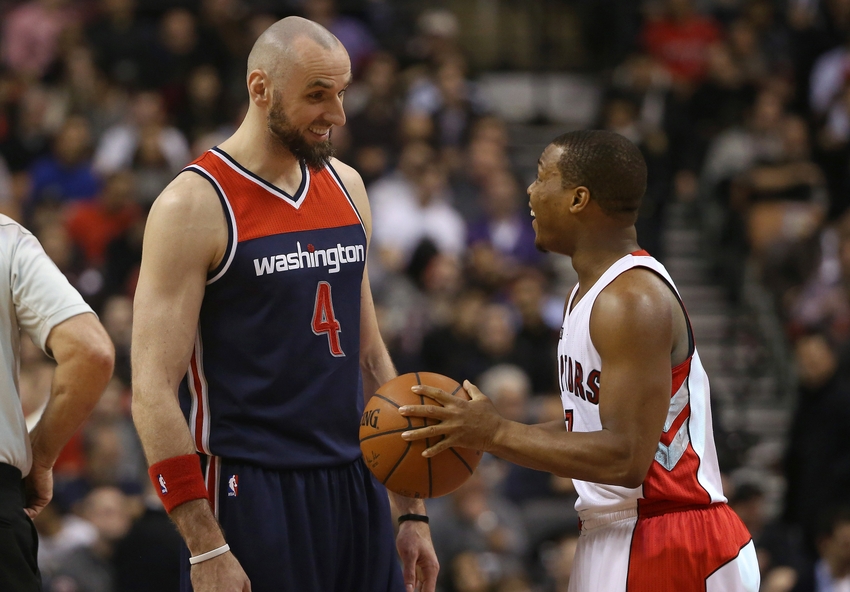Blake asked me to write a Breaking It down segment, so here goes. I loathe to do this to you
I’m going to focus on how the Raptors, in crunch time, couldn’t deal with Marcin Gortat screens. Gortat had 24 points on 11-15 FG, 13 rebounds, 4 blocks, and had a virgin sacrificed for him after the final whistle.
What’s this dribble-handoff you speak of?
You’d think the amount of dribble-handoffs the Raptors run they’d know how to defend one by now. Just look at how much they overplay the ball-handler (try not to laugh at Ross’s jump), and they’re still not able to prevent him from getting to the rim. Amir Johnson, after overplaying has no communication with Ross and his move to get back to Gortat provide enough space to Beal to get to the rim as DeMar DeRozan’s drop-down isn’t quick enough. If Beal had managed to pass the ball back to Gortat, he would’ve had either a layup, or a pass back out to Pierce for an open three. The heart of the Raptors defense here is completely broken by a dribble-handoff.
[gfy]AncientDearFrog[/gfy]
The silent quadruple-team
Here’s another Gortat screen, and both defenders go under it (what?) and there’s zero ball-pressure on Wall. To make matters worse, Patterson is sagging off of Porter and showing help on Wall even though he’s 10 feet away, leaving Porter wide open. For that matter, even Ross is coming down from the corner so Wall basically has his choice of shooter to pick out. This is essentially a quadruble-team with John Wall (based on minimal action) consuming Amir Johnson, Kyle Lowry, Patrick Patterson, and Terrence Ross. This is possibly the easiest basket Washington got all night, and it happened with the game on the line.
[gfy]UnripeWhichHare[/gfy]
Weak-side switching is in fashion
Another Gortat screen. Amir Johnson gets caught in no-man’s land, he’s not guarding Gortat or pressuring Wall, and on the weak side there’s immense confusion between Ross and Patterson who are switching for some reason. This weak-side switching is typical of the Raptors defense and always backfires. Weak-side switching is a dangerous thing because it’s usually caused by secondary action in the offense to create an open look for an off-the-ball man, and it’s alarming how easy it was for Pierce to get this wide open a look in crunch time.
[gfy]NiftyHighlevelFairybluebird[/gfy]
You can’t spell rotate without spelling rot
Another Gortat screen, this time played relatively well to start by Johnson as he’s at least blocked Wall’s path. The release-valve is Gortat, and DeRozan collapses on him as Johnson’s still getting back. Gortat’s pass to Pierce is a simple one and it’s an easy three. The rotation back out to Pierce is never made – my guess is that’s either Lowry or Johnson. This is basically one possible outcome of the first play shown in this post. Washington wants you to trap the big, so that they can free up their perimeter shooters, and the Raptors never really understood this.
[gfy]QuestionableFailingBasenji[/gfy]
—
All of the above is very basic. The Wizards are running an offense about as complicated as a middle school team, and the Raptors have proven ill-equipped to handle even initial action on sets. The aggressive trapping of the ball-handler is continually costing the Raptors because they’re not sharp enough to recover from that initial shift in the defense. Lacking defenders with instincts is a problem, and couple that with being asked to trap/rotate, the probability of missed rotations and fatigue rise.
Kudos to Randy Wittman for realizing that the Raptors had serious trouble, 1) having the PG stick with John Wall on a high screen, 2) the big making the rotation down to Gortat after trapping the ball-handler, and 3) making a secondary rotation in the event of help collapsing on Gortat.
I can’t write more. I’ve been flogging this horse for four months now.



